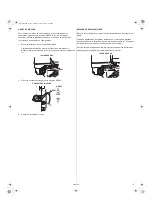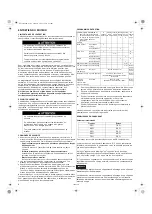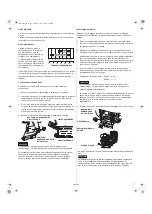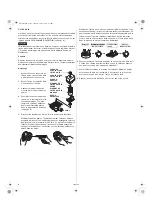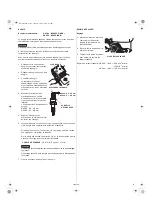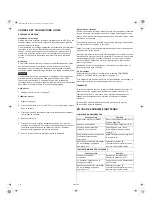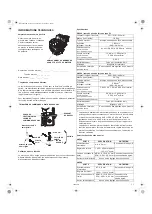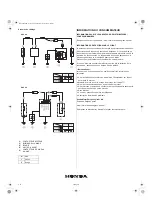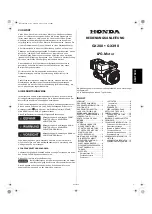
10
ENGLISH
HELPFUL TIPS & SUGGESTIONS
STORING YOUR ENGINE
Storage Preparation
Stop the engine and close the LPG supply valve. For Indonesia
models, release the low pressure regulator before removing the
hose.
Proper storage preparation is essential for keeping your engine
trouble-free and looking good. The following steps will help to keep
rust and corrosion from impairing your engine’s function and
appearance, and will make the engine easier to start when you use
it again.
Cleaning
If the engine has been running, allow it to cool for at least half an
hour before cleaning. Clean all exterior surfaces, touch up any
damaged paint, and coat other areas that may rust with a light film
of oil.
Using a garden hose or pressure washing equipment can force
water into the air cleaner or muffler opening. Water in the air
cleaner will soak the air filter, and water that passes through the
air filter or muffler can enter the cylinder, causing damage.
Engine Oil
1. Change the engine oil (see page 7).
Engine Cylinder
1. Remove the spark plug.
2. Pour a teaspoon 5–10 cm
3
of clean engine oil into the cylinder.
3. Pull the starter grip several times to distribute the oil in the
cylinder.
4. Reinstall the spark plug.
5. Pull the starter grip slowly until resistance is felt. This will close
the valves so moisture cannot enter the engine cylinder. Return
the starter grip gently.
6. Cover the engine to keep out dust.
Storage Precautions
Select a well ventilated storage area away from any appliance that
operates with a flame, such as a furnace, water heater, or clothes
dryer. Also avoid any area with a spark-producing electric motor, or
where power tools are operated.
If possible, avoid storage areas with high humidity, because that
promotes rust and corrosion.
Keep the engine level in storage. Tilting can cause oil leakage.
With the engine and exhaust system cool, cover the engine to keep
out dust. A hot engine and exhaust system can ignite or melt some
materials. Do not use a plastic sheet as a dust cover.
A nonporous cover will trap moisture around the engine, promoting
rust and corrosion.
Removal from Storage
Check your engine as described in the
BEFORE OPERATION
CHECKS
section of this manual (see page 3).
If the cylinder was coated with oil during storage preparation, the
engine will smoke briefly at startup. This is normal.
TRANSPORTING
If the engine has been running, allow it to cool for at least 15
minutes before loading the engine-powered equipment on the
transport vehicle. A hot engine and exhaust system can burn you
and can ignite some materials.
Before you transport the engine, the LPG hose must be
disconnected.
You must disconnect the LPG hose.
TAKING CARE OF UNEXPECTED PROBLEMS
ENGINE WILL NOT START
ENGINE LACKS POWER
Possible Cause
Correction
Engine switch OFF.
Turn engine switch to ON
position.
Out of fuel.
Refuel (p. 6).
Engine oil level low (Oil Alert
models).
Fill with the recommended oil to
the proper level (p. 7).
Spark plug faulty, fouled, or
improperly gapped.
Gap or replace spark plug
(p. 9).
Mixer malfunction, ignition
malfunction, valves stuck, etc.
Take engine to your servicing
dealer, or refer to shop manual.
Possible Cause
Correction
Filter element (s)
restricted.
Clean or replace filter element (s)
(p. 8).
Fuel quality or pressure is poor. Use a reliable LPG source.
Mixer malfunction, ignition
malfunction, valves stuck, etc.
Take engine to your servicing
dealer, or refer to shop manual.
3RZ1C8000.fm Page 10 Friday, April 13, 2018 9:19 AM

















